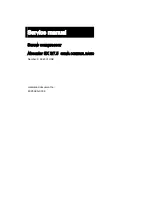
6: Maintenance
ShopTek™ ST45, ST55, ST75 (U.S.A. & Mexico) Operation & Maintenance Manual
88292021-240 R01
40
Subject to EAR, ECCN EAR99 and related export control restrictions.
• A current detection device in the electrical cabi-
net of the compressor provides motor overload
protection.
• The motor should not make intermittent or
unusual noises or vibrations when running
(either at no load or load).
6.5.2
Main motor maintenance and repair
• The operating environment should be dry, the
motor surface should be clean, and the motor’s
air inlet should not be blocked by dust or fibers.
• When the motor overload protection device
shuts down the compressor, do not restart the
compressor until you find and eliminate the
cause of the overload.
• Make sure bearings are well lubricated. Grease
should be added or replaced every 2000 hours.
If grease becomes too hot or deteriorates
during operation, replace it. Before adding
grease, clean the bearing and cap slot. Differ-
ent motors use different types of grease. See
the motor nameplate for the type of grease
needed.
• Replace the bearings at the end of their service
life. (At the end of the bearings’ service life, the
motor will create significantly more noise and
vibration).
• After any motor faults occurs, contact your Sul-
lair representative.
6.5.3
Periodic inspection of the main
motor
You should inspect the main motor yearly to ensure that
the motor is operating correctly and in good condition.
You should inspect the motor every six months if the
compressor is exposed to any of these conditions:
• Corrosive or conductive dust
• Excessive dirt or dust (the accumulated dust
may interfere with the compressor’s ventilation)
• Chemical smoke, steam, salt mist, or oil mist
• A very wet or very dry atmosphere
• Radiant heat
• Pests or mold
You should also inspect the main motor every six months
when the compressor runs under nonstandard condi-
tions, such as:
• The rated voltage and/or frequency often devi-
ates from the limits set under
Section 6.5.1:
Main motor operation
.
• The compressor is in a room with either poor
ventilation or an ambient temperature over
40°C (104°F).
• The motor starts and stops often because of
frequent fluctuations in air demand.
6.5.3.1 Periodic inspection checklist
• Add or change the main motor bearing grease
according to the maintenance schedule.
• Inspect the bearing seal and eliminate oil leaks
you find.
• Check the end cover and the shroud for con-
densation, deposited water, iron rust, or corro-
sion.
• Check for excessive dust or other foreign mate-
rial.
• Check the main lead-out wiring for overheating
or a corona discharge.
• Tighten the non-insulated electric connections
and check them for overheating, corrosion, or
electrical arcing.
• Tighten all nuts and bolts.
6.5.4
Check and clean the windings
The best way to clean the motor windings depends on
both the accessibility of the surface and what you are try-
ing to remove from it. For a thorough cleaning, or if the
winding is very dusty, the rotor needs to be removed from
of the stator.
6.5.4.1 Dry cloth
You can clean easy-to-reach surfaces that are dusty with
a dry, clean, lint-free cloth.
WARNING
Isolate the compressor from the power supply
before making any repairs or adjustments to the
drive coupling.
WARNING
Isolate the compressor from the power supply
before checking or cleaning the windings.
















































